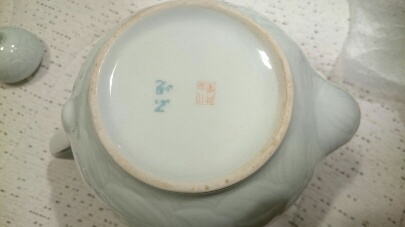
|
Subject:Re: Help me to identify my teapot 2.
Posted By: I.Nagy Tue, Jan 26, 2021
Dear John,
One thing is sure, 石峴 is a place name (cca. Stone Hill). The second character 峴 is used in Korean and Chinese place names only - there is not Japanese place name containing this character. So the Japanese origin can be ruled out by all odds. In Korea I have found at least two village names with these characters - but it can be a place name within a larger town or city, too.
The village name - Seok-Hyeon - is not romanized, it is in Korean Hangul script and in Chinese characters in parentheses, therefore you can't Google it up in English.
After this there is nothing left but the transcription of the kiln name into romanized Korean 八山陶窯 Palsan do-yo "Palsan Pottery Kiln"
For better understanding, in Korea the change of writing system from the pre-war historic Hanja (Chinese character) mixed with Hangul (Korean alphabet) use has now entered into its final stage
the Hangul (Korean alphabet) only use with the full spread of internet. For example the Korean version of Google uses only Hangul script, however some segment of the society is still using the traditional Chinese characters e.g. pottery industry etc. There is an another problem with the romanization of the Korean language, they use at least 3 different systems. According to them
our village name can be romanized as;
Seok-hyeon, Sôk-hyôn or Sek-hyen
By the way, I noted that your teapot looks more Korean than Japanese.
With regards,
I.Nagy


|
 Help me to identify my teapot 2.
Help me to identify my teapot 2.  ( China & Japan ) - John - Jan 20, 2021 (08:34 AM)
( China & Japan ) - John - Jan 20, 2021 (08:34 AM)  Re: Help me to identify my teapot 2.
Re: Help me to identify my teapot 2.  - John - Jan 21, 2021 (10:49 AM)
- John - Jan 21, 2021 (10:49 AM)  Re: Help me to identify my teapot 2. - I.Nagy - Jan 24, 2021 (07:36 AM)
Re: Help me to identify my teapot 2. - I.Nagy - Jan 24, 2021 (07:36 AM)  Re: Help me to identify my teapot 2. - John - Jan 25, 2021 (03:15 PM)
Re: Help me to identify my teapot 2. - John - Jan 25, 2021 (03:15 PM)  Re: Help me to identify my teapot 2. - I.Nagy - Jan 26, 2021 (05:05 AM)
Re: Help me to identify my teapot 2. - I.Nagy - Jan 26, 2021 (05:05 AM)  Re: Help me to identify my teapot 2. - John - Feb 12, 2021 (12:53 PM)
Re: Help me to identify my teapot 2. - John - Feb 12, 2021 (12:53 PM) 


